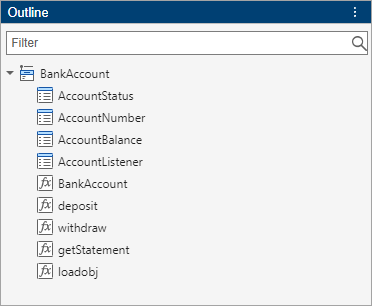编辑和格式化代码
要编辑代码,在编辑器和实时编辑器中,您可以使用列选择、代码自动补全和重构。要格式化代码并使代码更易于阅读,请使用缩进、文本宽度指示、代码折叠和“大纲”面板。
列选择
在编辑器和实时编辑器中添加或编辑代码时,您可以选择和编辑一个矩形区域的代码(也称为列选择或块编辑)。如果您要复制或删除几列数据(而不是若干行),或者要一次性编辑多行,则选择和编辑代码非常有用。要选择一个矩形区域,请在使用鼠标进行选择时按 Alt 键。在 macOS 系统上,请改用 Option 键。
例如,选择 A 中的第二列数据。

键入 0 可将所有选定的值设置为 0。

在 R2021b 之前的版本中: 列选择仅在实时编辑器中可用,在编辑器中不可用。
更改大小写
在编辑器和实时编辑器中,您可以将所选文本或代码的大小写从全部大写改为全部小写,反之亦然。选择文本,右键点击,然后选择更改大小写。您也可以按 Ctrl+Shift+A。如果文本中包含大写和小写文本,则 MATLAB® 会将它们全部更改为大写。
在 macOS 上,请使用 Command 键而不是 Ctrl 键。
在 R2021b 之前的版本中: 更改大小写选项仅在实时编辑器中可用,在编辑器中不可用。
复制和拷贝行
您可以在编辑器和实时编辑器中复制代码行。要复制代码行,请右键点击该行并选择复制行。您也可以按 Ctrl+Shift+C。在 macOS 上,请使用 Command 键而不是 Ctrl 键。
要在不选择代码的情况下复制代码行,请按 Ctrl+L 键盘快捷方式。要剪切代码行,请按 Ctrl+X。在 macOS 上,请改用 Command+C 和 Command+X 键盘快捷方式。 (自 R2025a 起)
在 R2021b 之前的版本中: 复制行选项仅在实时编辑器中可用,在编辑器中不可用。
自动补全代码
在编辑器和实时编辑器中输入代码时,MATLAB 会自动补全括号和引号。例如,如果您在编辑器或实时编辑器中键入左括号,MATLAB 会添加右括号。MATLAB 还会在您按 Enter 键时自动拆分注释、字符向量、字符串和括号。例如,如果您在注释中按 Enter 键,MATLAB 会将光标后的文本移至新行,并在新行的开头添加百分号 (%)。
MATLAB 还可以自动补全控制流语句以及函数和类定义中的块结尾。要自动补全块结尾,请在主页选项卡的环境部分中,点击  设置。选择编辑器/调试器 > 建议和自动补全,并在自动编码选项部分选择一个或多个自动补全块结尾选项。
设置。选择编辑器/调试器 > 建议和自动补全,并在自动编码选项部分选择一个或多个自动补全块结尾选项。
要撤消自动补全代码,请按 Ctrl+Z 或 撤消按钮。要禁用所有自动补全代码,请在编辑器/调试器 > 建议和自动补全设置的自动编码选项部分中,清除启用自动编码设置。或者,要仅禁用某些自动代码补全,请清除自动补全对组、在新行上自动补全和自动补全块结尾部分中的一个或多个设置。有关详细信息,请参阅 Editor/Debugger Settings。
在 R2021b 之前的版本中: MATLAB 仅在实时编辑器中补全代码,在编辑器中不会补全代码。
重构代码
您可以通过将选定代码区域转换为函数或局部函数(称为代码重构),将大型脚本或函数分成较小的部分。
要重构选定的代码区域,请执行以下操作:
选中一行或多行代码。
在编辑器或实时编辑器选项卡的代码部分中,点击 重构并从可用选项中进行选择。
输入新函数的名称。MATLAB 会用选定的代码创建函数,并将原始代码替换为对新创建函数的调用。
在 R2021b 之前的版本中: 重构选项仅在实时编辑器中可用,在编辑器中不可用。
缩进代码
缩进代码使函数和语句(例如 while 循环)更易于阅读。默认情况下,当您在编辑器和实时编辑器中键入时,MATLAB 会自动缩进代码。这称为智能缩进。当您使用制表符或空格缩进代码行时,MATLAB 还会将后续代码行与这些代码行对齐。
如果智能缩进被禁用,要缩进选定代码行,请转至编辑器或实时编辑器选项卡,在代码部分中,点击“智能缩进” 按钮。
按钮。
要手动将选定代码行的缩进更改为更靠右或靠左,请在编辑器或实时编辑器选项卡上,点击“增加缩进” 或“减少缩进”
或“减少缩进” 按钮。无论智能缩进是启用还是禁用,手动更改缩进都有效。您也可以分别使用 Tab 键或 Shift+Tab 键。
按钮。无论智能缩进是启用还是禁用,手动更改缩进都有效。您也可以分别使用 Tab 键或 Shift+Tab 键。
禁用智能缩进
如果您不喜欢使用智能缩进,可以禁用它。MATLAB 中支持智能缩进的每种语言都有自己的禁用智能缩进设置。
在主页选项卡的环境部分中,点击 设置。
选择 MATLAB > 编辑器/调试器 > MATLAB 语言或 MATLAB > 编辑器/调试器 > 其他语言 >
language name,其中language name是您要禁用智能缩进的编程语言。在 R2025a 之前的版本中: 选择 MATLAB > 编辑器/调试器 > 语言,然后在语言下拉列表中选择一种编程语言。
在选定语言的缩进部分中,清除键入时应用智能缩进设置。并非所有语言都支持此设置。
更改缩进行为
您可以在编辑器和实时编辑器中更改缩进行为。
要更改 MATLAB 代码文件中函数的缩进方式,请在主页选项卡的环境部分中,点击 设置。选择 MATLAB > 编辑器/调试器 > MATLAB 语言。然后,在缩进部分中,从函数缩进格式选项中进行选择。有关每个函数缩进格式的详细信息和示例,请参阅Editor/Debugger Settings。
要更改智能缩进的行为,请转至 MATLAB > 编辑器/调试器 > 缩进设置,并清除或设置一个或多个智能缩进设置。有关详细信息,请参阅 Editor/Debugger Settings。
在 R2025a 之前的版本中: 要更改 MATLAB 代码文件中函数的缩进方式,请选择 MATLAB > 编辑器/调试器 > 语言。要以编程方式更改智能缩进的行为,请使用 matlab.editor 设置。例如,以下代码会在自动缩进时启用整个文档的格式化。有关详细信息,请参阅matlab.editor 设置。
s = settings; s.matlab.editor.indent.SmartIndentEntireDocument.PersonalValue = 1;
折叠代码
代码折叠在编辑器中展开和折叠 MATLAB 代码块。您可以使用代码折叠来隐藏当前不处理的代码。代码折叠可提高包含大量函数或其他代码块的文件的可读性。实时编辑器不支持代码折叠。
例如,您可以折叠:
代码节
for和parfor代码块函数代码
类代码
多行注释
要展开或折叠代码块,请在编辑器中点击显示在构造左侧的加号 ![]() 或减号
或减号 ![]() 。您也可以使用 Ctrl+Shift+.(句点)和 Ctrl+.(句点)键盘快捷方式,或使用视图选项卡中的代码折叠按钮。
。您也可以使用 Ctrl+Shift+.(句点)和 Ctrl+.(句点)键盘快捷方式,或使用视图选项卡中的代码折叠按钮。
要展开或折叠一个文件中的所有代码,请将光标放在文件中的任意位置,转至视图选项卡,然后选择全部展开  或全部折叠
或全部折叠  按钮。您也可以使用 Ctrl+Shift+,(逗号)和 Ctrl+,(逗号)键盘快捷方式。
按钮。您也可以使用 Ctrl+Shift+,(逗号)和 Ctrl+,(逗号)键盘快捷方式。
注意
如果您打印的文件包含一个或多个折叠构造,这些构造将在该文件的打印版本中展开。
您可以更改哪些编程构造可折叠,以及首次打开 MATLAB 文件时是否折叠某编程构造。在主页选项卡的环境部分中,点击 设置。选择编辑器/调试器 > 代码折叠,然后调整设置选项。
更改右侧文本限制指示标记
默认情况下,编辑器中的第 75 列会显示浅灰色的竖线(参考线),指示超过 75 个字符的行的位置。您可以将此文本限制指示标记设置为其他值,例如,如果您想在具有不同行宽限制的另一文本编辑器中查看代码,这很有用。实时编辑器不支持右侧文本限制指示标记。
要隐藏或更改竖线的外观,请执行以下操作:
在主页选项卡的环境部分中,点击 设置。
在“设置”窗口中,选择 MATLAB > 编辑器/调试器 > 显示。
调整右侧文本限制部分中的设置。
右侧文本限制指示标记仅是视觉提示,并不能防止文本超出限制。要在指定的列号使注释文本自动换行,请转至主页选项卡,然后在环境部分中,点击 设置。选择 MATLAB > 编辑器/调试器 > MATLAB 语言,并调整注释格式设置设置。
在 R2025a 之前的版本中: 选择 MATLAB > 编辑器/调试器 > 语言,并在语言字段中选择 MATLAB。
查看代码大纲
自 R2025a 起
在编辑器和实时编辑器中,您可以使用“大纲”面板查看 MATLAB 代码文件的简要大纲。要查看在编辑器或实时编辑器中打开的文件的大纲,请转至视图选项卡,在工具部分中,点击大纲。要导航到代码文件中的某个区域,请双击“大纲”面板中的相关条目。
